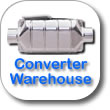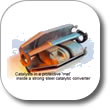A Catalytic Converter is designed to last the life of the vehicle as long as the vehicle is maintained properly. There are no moving parts in a catalytic converter. As the exhaust stream flows through the converter it takes the raw emissions Hydrocarbons (HC), Carbon Monoxide (CO), and Nitric Oxide (NOx), and reduces the levels of these to acceptable standards required by E.P.A. (Environmental Protection Agency) and C.A.R.B. (California Air Resources Board).
The most common reason for replacing an OBDII converter is PO420 code which is “Catalyst Inefficiency”. This is caused when the rear oxygen sensor is reading a fluctuation that is greater than the vehicles computer allows. NOTE: The oxygen sensors do not measure Hydrocarbons, Carbon Monoxide, or Nitrus Oxide. The oxygen sensors only measure the oxygen retention of the catalyst. If there is any type of air leak it could trip this code. * We have found that using a higher octane fuel than the manufacturer recommends can cause red light problems. It will cause too much carbon to be built up and trip the PO420 code.* The following are the major components to check on the vehicle before replacing a defective converter.
Just replacing the converter may not fix the problem!
The Major causes for a converter failure. *Any Emission Control Equipment that is Malfunctioning. e.g. Oxygen Sensors, Engine Coolant Temperature Sensor. *A Vehicle not Tuned Up. e.g. check plugs, wires, rotor cap and any Factory Scheduled Maintenance. *Carburetor, Throttle Body Injectors, Ported Fuel Injector Problems, * Contaminates in the Fuel system. e.g. Lead, Oil, Silicone, Phosphorus, or Coolant. * Worn Piston Rings or Valve Seals An engine with a mechanical problem or if it is improperly tuned can cause premature converter failure. The manufacturer’s warranty will not cover converter failure that is caused by engine malfunction or contaminated fuel.
*** CARBON BUILD UP is a major problem. Carbon releases oxygen and will give an incorrect oxygen sensor reading causing the air fuel mixture to be incorrect. This also causes more carbon to build up because of the incorrect fuel mixture. Carbon needs to be cleaned out to maintain proper air fuel mixtures.
CHECK LIST:
1. Oxygen Sensor
2. Engine Coolant Temp. Sensor (ECT)
3. Throttle Position Sensor (TPS) 4. EGR Valve
5. EGR Valve Position Sensor (EVP)
6. Air Charge Temperature(ACT) Sensor
7. Ported Vacuum Switch (PVS) Sensor
8. Vacuum Hoses
9. Manifold Absolute Pressure (MAP) Sensor
10. Barometric Absolute Pressure Sensor
11. Idle Speed Control Motor
12. Idle Air Control (IAC) Valve
13. Air Pump Check Valve
14. Air Injection Tubes
15. Throttle Body Injector (TBI)
16. Fuel Injectors
17. Mixture Control Solenoid
18. Canister Purge Valve
19. Spark Plug Wires
20. Air Filter
21. Exhaust Leaks






